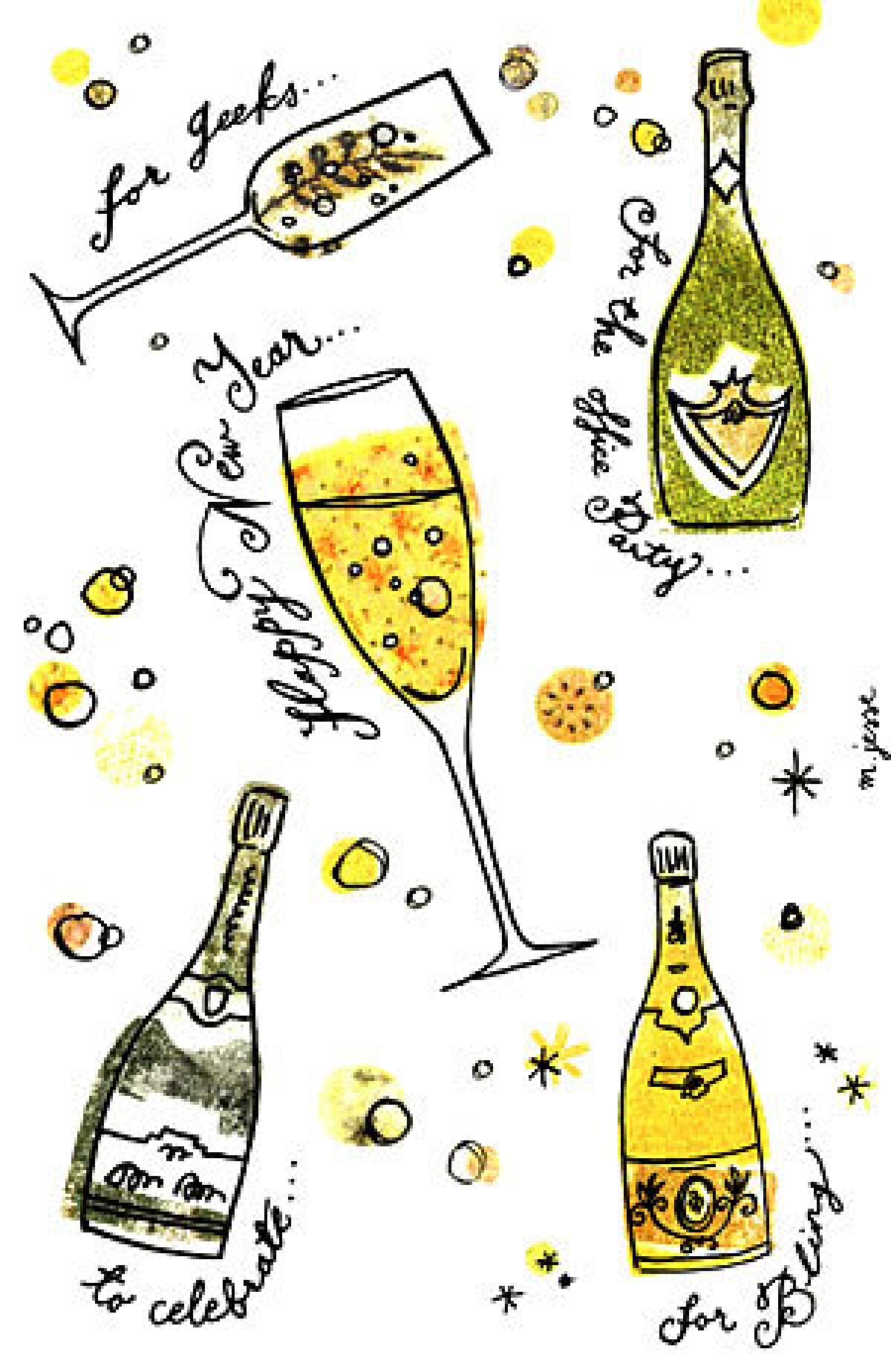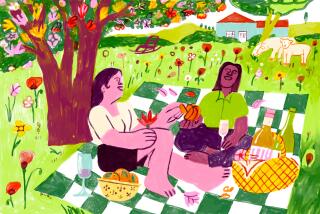A Champagne (or sparkling wine) for every occasion

- Share via
Let’s agree to set aside the grim recessionary landscape for the moment: The time has come for bubbles. There is simply nothing like a glass of sparkling wine to set this season apart. Welcoming, smile-inducing, instantly festive, bubbles give every holiday occasion a lift.
Of course, not every occasion is the same: The wine for the office party, the New Year’s party and the family toast aren’t necessarily going to come from the same bottle. Nor should they.
But that’s not a problem, we have a world of choices available. We’re in a kind of a golden age of bubbles, and the range of flavors, moods and prices has never been broader. So here are a few strategies for finding the right bubbles for the right occasion.
* Bubbles to celebrate your crummy bonus: Despite the fact that you’ll be tempted by sterner stuff than bubbles, the bleak economic edge to this holiday season calls for a wine that is legitimately happy-making, modestly indulgent and can provide the small victory of being a bargain.
The dollar-to-euro exchange rate continues to favor California here. Generally, California sparkling wines aren’t quite as fine as Champagne, but what they lack in delicacy they usually make up for in richness, roundness, a touch of zaftig luxury. They’re better-made than ever before and significantly cheaper than Champagne.
Take the nonvintage Brut from Roederer Estate ($22), the Anderson Valley satellite of the great Champagne house Louis Roederer, a wine with notes of pear and a feathery wisp of yeast in the aromatics that will make you think of freshly baked dinner rolls. Or J Winery’s “Cuvée 20” (about $25), a satiny sparkling wine that tastes like sweet pear nectar garnished with a spritz of lemon; a bit more lush than Champagne, but, sweetheart, you’re worth it.
* Bubbles for the holiday lunch, office party and related forms of forced mirth: You may enjoy the company of your fellow employees, you may even genuinely like a few, but without libations, nothing born of a fun committee will ever meet its goal. The right bubbles, though, could help.
There are three criteria for the office party: The wine must be bright, uncomplicated and unabashedly delicious. It must be cheap, so it can be plentiful, and it must be low in alcohol, so the party can safely carry on into the night.
All three objectives are easily met with Cava and Prosecco, the signature bubbles from Spain and Italy, respectively. Proseccos from the Veneto in northern Italy have a luminous color, a light, refreshing, mildly peachy flavor and a wonderfully creamy texture -- to go along with alcohol levels hovering in the single digits. There are many excellent choices, but Mionetto’s Brut ($15) and Nino Franco’s robust, slightly floral “Rustico” ($18) are good bets.
Most Spanish Cavas come from Catalonia, on the Mediterranean coast. They’re usually drier, more lemony and angular than Prosecco, with a mineral texture that’s nervy and pure, making them good sippers but superb, too, with a meal, especially seafood. There are several in the market, but two of my current favorites are the modern, sleek 2007 “Tarantas” ($13) and the more bracing Brut Nature from Juve y Camps ($18).
* Bling bubbles: Bling is a funny thing. By definition, it’s all flash without substance, but few well-made wines fit that description. Of course, many a Champagne is revered for reasons that have little to do with how it tastes. Why, for example, was Cristal, the sublime tête de cuvée from Louis Roederer (2002, about $250), the preferred beverage of rap culture? I’m guessing that it’s not because Jay-Z and 50 Cent invited Ludacris and Young Jeezy over for a comprehensive blind tasting of top vintage Champagnes. Whereas for sommeliers, who do gather for such tastings, the bling Champagne has always been vintage Krug (about $135).
Champagne houses don’t shy away from the bling quotient -- if anything, they embrace it. Why else would Dom Perignon introduce a jeroboam (four bottles’ worth) of its 1995 vintage, wrapped in a sheath of white gold? (Expect to pay $15,000.) Not to be outdone, Perrier-Jouët rolled out a hundred-case special edition of its 1998 “Belle Epoque Blanc de Blancs” for about $6,500 a bottle, surpassing Krug’s “Clos d’Ambonnay,” at merely $3,500.
None of these can compare with the bottles of vintage 1907 Heidsieck salvaged from a shipwreck off Finland, now selling for $275,000 a bottle. All you have to do is travel to the Ritz-Carlton in Moscow to try it.
Sometimes the best approach is to find a tête de cuvée that will be appreciated not for its bling value but for its “wow” factor -- and here we’re talking about taste. Cristal is all well and good, but the 1995 Charles Heidsieck “Blanc des Millenaires” (about $110) is just as posh and less than half the price. Krug’s single-vineyard Blanc de Blancs, “Clos du Mesnil” (1996, which can go for as much as $1,300) is peerless, unless the peer is Pierre Peters “Cuvée Reservé Grande Cru Le Mesnil” from the same village. (The 1999 can be had for the relatively astonishing price of $70.) And sometimes the best juice of all is virtually bling-free: The rare “Clos des Goisses,” from Philipponnat (1999, $185), might be the most gorgeous Champagne you’ve never heard of.
* Bubbles to bring out the wine geek in you and your friends: To geek out on something really out of the ordinary, you don’t even have to leave France. Sample some of its many Cremants and Petillants -- bubbles not from Champagne. Most come from the Loire, Alsace and Burgundy, like the earthy, savory Touraine JM “Brut Rosé” from Monmousseau ($15), Chateau d’Orschwihr’s toasty Cremant d’Alsace ($15), Louis Bouillot’s succulent Cremant de Bourgogne Rosé ($15) or the rosy, mildly sweet Bugey-Cerdon pinks, like “La Cueille,” from Patrick Bottex ($23).
Blasting still further into geek orbit, consider having Sekts. These are bubbles with a Germanic accent, as in the sparkling German Riesling from Kalinda ($18) or a sparkling blend of Austrian Pinot Noir, Riesling and Gruner Veltliner from Schloss Gobelsburg ($30); both are unusual and delicious.
The Southern Hemisphere is getting into the act too. In cool Tasmania, a small sparkling industry is bubbling over, like the unexpectedly suave Brut from Clover Hill (2004, $30). Australia, meanwhile, has made sparkling Shiraz a guilty pleasure for some (myself included). You can find good ones from Hardy’s ($20), Hill of Content ($14) or, the winner in the names contest, “the Black Chook” ($17) from (wait for it) Woop Woop. Though none of these are the wines with which to ring in the new year, have them on hand the next time you need to murder a charcuterie plate.
Alas, for New Year’s, it really should be Champagne. . . . and geeks of all kinds love Champagne, particularly if the geek in question hasn’t heard of the Champagne in question, which may include any number of the brilliant, idiosyncratic grower-producers that make small lots of exquisite Champagne outside the realm of the big houses, or Grandes Marques. Consider the Champagnes of Agrapart, Pierre Gimonnet, Paul Bara, Larmandier-Bernier, Jean Milan and Camille Savès.
There are more than 3,000 of them, after all (in number, they dwarf the Grandes Marques, though the big houses produce vastly more wine), with more being imported every year -- enough for many New Year’s geek fests to come.
More to Read
Sign up for The Wild
We’ll help you find the best places to hike, bike and run, as well as the perfect silent spots for meditation and yoga.
You may occasionally receive promotional content from the Los Angeles Times.










